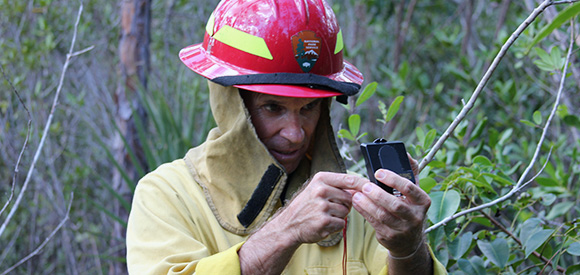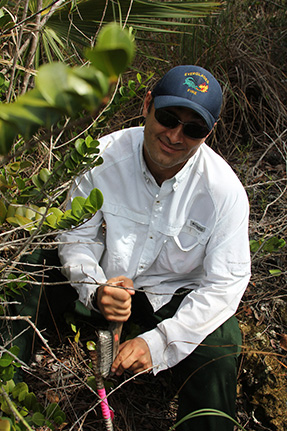Everglades fire staff are walking in the footsteps of Bill Robertson, the park’s first fire control aid starting in the late 1950s, trying to relocate his research plots, which are part of a larger project to see how the condition of the pine rocklands has changed. Revisiting Robertson’s plots will allow additional research information to be gathered and compiled with existing data, giving fire managers a better picture of how the landscape has changed with time.

Relocating Research Plots

Dr. William (Bill) Robertson was Everglades National Park’s first fire control aid starting in the late 1950s. From 1958 to 1965, Bill Robertson installed the first set of fire effects plots in the pine rocklands of Everglades National Park, leading to the discovery that the pine rocklands benefit from fire. Robertson’s plots and the data collected relating to fire ecology and habitat succession were instrumental in changing the perception of fire in the National Park Service. As a result, Everglades National Park instituted the first agency-approved prescribed fire in National Park Service in 1958.
Today, Everglades fire staff are walking in the footsteps of Bill Robertson trying to relocate these pioneering plots, which are part of a much larger monitoring project to see how the condition of the pine rocklands has changed since Robertson’s original study. Revisiting Robertson’s plots will also allow additional research information to be efficiently gathered and compiled with previously captured fuels and fire effects data, giving fire managers a better picture of how the landscape has changed throughout time. Reusing Robertson’s plots will also avoid the installation of additional plots in designated wilderness areas.
Thus far, Everglades fire staff have located approximately 90 percent of Robertson’s original plots. Robertson measured the diameter at breast height and tree heights on all pine trees, counted and classified shrubs into height categories, and counted all species present in the plot. Presently, members of the fire staff intend to gather additional data on pine seedlings and overstory, shrub cover, and species richness. Fire staff will collect data to analyze long-term trends in vegetation composition and determine the effects of the absence of fire in the pine rocklands. This data can also be used to aid in determining expected fire behavior and the magnitude and intensity of fire spread.
Photo monitoring will be added to the data collection by recreating one photo (similar to Robertson’s photo) and a 360-degree panoramic photo in the center of the plot. Fire staff document the vegetation status of the plot with pre-burn photos, followed by post-burn photos to monitor fire’s effects on the plot. These photos will be used in conjunction with the quantitative data collected in the plots.
Fire managers hope that the new data will provide insight necessary for maintaining this fire-adapted ecosystem. Everglades National Park contains one of the largest tracts (approximately 20,000 acres) of the critically imperiled pine rockland ecosystem in South Florida. Composed predominantly of Florida slash pine (Pinus elliotii var. densa), the pine rockland community in Everglades National Park has a diverse understory of both temperate and tropical plants, many of which are endemic or found only in pine rocklands. Everglades’ pine rocklands depend on fire to provide healthy habitat for multiple threatened and endangered species, including two federally listed endangered butterflies, Bartram’s hairstreak and Florida leafwing, and several rare and endangered plants, including deltoid spurge.
Read more information on pine rocklands.
Contact: Rick Anderson, Fire Management Officer
Email: e-mail us
Phone: (305) 242-7853
Last updated: December 14, 2017
